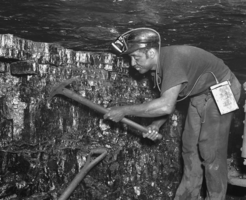 | Back to e-WV
| Back to e-WV
 The West Virginia Encyclopedia
The West Virginia Encyclopedia
 | Back to e-WV
| Back to e-WV
 The West Virginia Encyclopedia
The West Virginia Encyclopedia

Most early mines in West Virginia were of the drift entry type, which presented fewer logistical problems than vertical shaft mines and required minimal capital to open. Drift mines were located where an outcrop of coal was found on a hillside, allowing miners to tunnel directly and horizontally into the seam.
Most operations used the room-and-pillar method. Miners drove parallel main tunnels called entries from the entry point toward the mine’s other side. Mining then proceeded in reverse fashion, from the farthest point back toward the front. Breakthroughs connected main tunnels at specified intervals. The ‘‘mains’’ were generally named according to their direction, such as North Main or Southwest Main. Miners advanced side entries at right angles to the mains, with designations such as 1st Left, 2nd Left, or 3rd Right depending on their relationship to the mine opening and main entries. The rectangular block of coal outlined by the side entries and the mains—perhaps 500 by 2,000 feet—created a panel. Miners then opened rooms with connecting breakthroughs through this panel. Smaller blocks of coal—for instance 75 by 80 feet—between breakthroughs and adjacent rooms, known as pillars, were left in place to support the roof. Miners extracted or ‘‘pulled’’ the pillars as a last step in mining an area, getting the last of the coal while retreating toward the side entries and permitting the roof or top to fall behind them. It was the most dangerous part of the work.
Ventilating the myriad of tunnels was complicated. A few early mines relied on natural ventilation or used large furnaces to create a draft. By 1900, steam and electric fans made larger mines possible. Trap doors at strategic points and the construction of masonry or wooden stoppings in breakthroughs established a path for air to follow. Many operations continued the dangerous practice of circulating the same air from one working section to another until late in the 20th century. As a result, liberated gasses, dust, and powder smoke permeated the atmosphere of the last working section in the air cycle.
In a room or entry, the solid coal to the miner’s front was the face, the pillar walls to the sides the ribs, and any discarded refuse the gob. One or two miners worked a place, depending on the room or entry width. The miners loaded coal by hand. Hand loaders owned their own implements, but paid tool maintenance fees for the operation’s blacksmiths and purchased blasting powder from the company.
Hand mining required skill, and young miners usually served an apprenticeship under a relative. Lying on their sides, miners first used a pick to undercut the coal three to four feet deep. Undercutting required two to three hours each shift, and standing water often made the task particularly unpleasant. Based on his knowledge of the coal seam, the miner then chose the appropriate places to manually drill the coal face and tamp the holes with explosives. Well placed, the subsequent blast dislodged the coal as far back as the undercut. Poorly placed, the shot broke away little or no coal, and dropped the material in a solid block. This was known as a hung shot. Careless or unskilled blasting preparations could produce a blown-out shot that suspended and ignited the coal dust. After shooting, miners loaded the coal into a mine car, set timber roof props, and extended the track for the next cycle. Throughout the process, skilled miners read the geological signs and sounds for danger.
Mule drivers gathered the loaded mine cars from the various rooms and delivered empties. They took strings or trips of the loaded cars to the main entries for transfer to the outside. Although by 1900 many mines used compressed-air, steam, or electric mine locomotives for mainline haulage, mules remained a significant part of the process into the 1920s. Boys as young as nine served as trappers, opening and closing ventilation trap doors to permit the passage of these trips.
Because of the skill required and their freedom from direct supervision at the working face, hand loaders developed a strong sense of pride and independence. Machines took over the undercutting step early in the century, but the basic routine of manual drilling, blasting, and loading remained prevalent through the 1930s.
Written by Paul H. Rakes
Dix, Keith. What's a Coal Miner to Do?. Pittsburgh: University of Pittsburgh Press, 1988.
Tams, W. P. The Smokeless Coal Fields of West Virginia. Morgantown: West Virginia University Libraries, 1964.